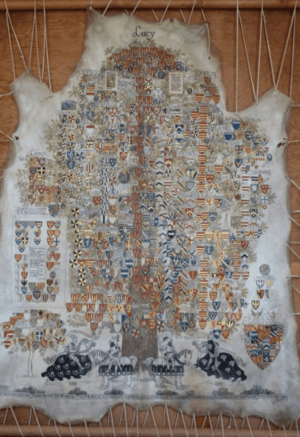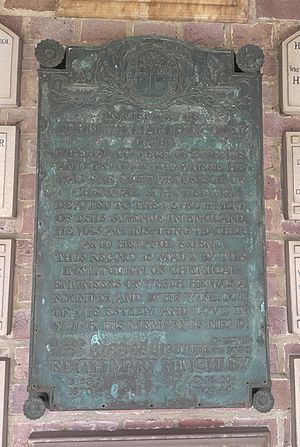Edith Mary Hinchley facts for kids
Quick facts for kids
Edith Mary Hinchley
|
|
|---|---|
| Born |
Edith Mary Mason
1870 |
| Died | 16 October 1940 Kensington, London
|
| Nationality | British |
| Other names | Mrs J W Hinchley |
| Education | Royal College of Art |
| Occupation | artist |
| Spouse(s) | John William Hinchley |
Edith Mary Hinchley, born Edith Mary Mason (1870 – 16 October 1940), was a talented British artist. She was known for her paintings, her support for women's right to vote, and her belief in humanism.
Contents
About Edith Mary Hinchley
Edith Mary Hinchley was born in 1870 in Chelsea, a part of London. Her father was a florist, growing and selling flowers. Her mother and sisters ran a shop.
Early Life and Art School
After her father passed away in the 1880s, Edith became a student at the Royal College of Art. This was a very important art school. She was so good that she won a silver medal there!
From 1897 to 1928, Edith showed her artwork in many famous places. She displayed 27 pieces at the Royal Academy of Arts in London. She also showed her art at the Royal Glasgow Institute of the Fine Arts, the Royal Hibernian Academy, and even in Paris at the Paris Salon.
In 1896, she became a member of the Royal Society of Miniature Painters. Later, in 1922, she joined the Society of Women Artists. These were big achievements for an artist.
The Lucy Deerskin Project
In 1890, Edith worked on a very special project. She helped create a family tree by painting 500 heraldic shields on deerskin. Heraldic shields are like family crests or symbols. She was chosen for this work because she was good at researching family histories.
This amazing piece, called the Lucy Deerskin, is now kept at Charlecote Park in Warwickshire. It is owned by the National Trust, an organization that protects historic places.
Life in Thailand
In 1903, Edith married John William Hinchley. He was a chemical engineer whom she had met at the Royal College of Art. When she was an art student, it was a bit difficult for her. She had some hearing problems, and because she was a woman, she had to sit at the back of the class. There was even a special chaperone, called a matron, who sat between male and female students!
In 1903, her husband moved to Siam, as it was called then. He worked there as an expert in metals at the Bangkok mint. Edith sailed to join him in 1904. She continued to paint during her time in Thailand. They both returned to Britain in 1907.
Fighting for Women's Rights
Edith was a strong supporter of women's rights. In 1911, she wrote about how women artists quickly joined the movement to get women the right to vote. This movement was called the suffrage movement.
Her article was published in a newspaper called The Vote. This newspaper belonged to the Women's Freedom League. This group was a bit more active in their protests than some other suffrage groups. They wanted more fairness and democracy for women.
Art and Collections
In 1913, Edith donated three special embroidered robes to the Victoria and Albert Museum. These robes were from North Africa, and one was made of silk. This shows her interest in different cultures and textiles.
In 1923, Edith was asked to paint a tiny portrait, called a miniature. It was a painting of Princess Helene Victoria. This miniature was meant to hang in the library of Queen Mary's Dolls' House. The painting still exists today and might be painted on a thin material called vellum.
After her husband passed away in 1931, Edith continued her passion for history. In 1935, she started giving old objects to the British Museum. These items included ancient metal coins and porcelain pieces, some dating back to 150 BCE!
Around 1937 or 1938, she painted a portrait of Evan Frederick Morgan. This painting is now part of the National Trust's collection.
Death and Legacy
Edith Hinchley passed away in London in 1940. Her house in Kensington was completely destroyed by a bomb during The Blitz, which was a time of heavy bombing in London during World War II. She died in the attack.
One of her paintings, called A Leper in Prapatoom, which she finished in 1905, is now in the Wellcome Collection. Edith Mary Hinchley is remembered for her beautiful art, her dedication to women's rights, and her contributions to historical collections.
Images for kids




